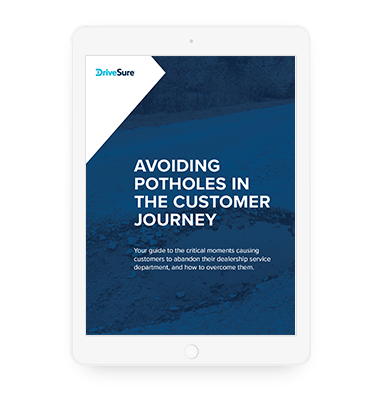Multi-point inspections (MPIs) are a great way to identify maintenance opportunities to sell more services. So what if your MPIs were better at driving sales? Not only could this dramatically improve customer satisfaction and retention, but it can also drive your dealership’s profitability.
By refining the MPI process, dealerships can transform a routine check-up into a strategic asset, ensuring that every car leaves the lot not just serviced, but thoroughly vetted — and with potential issues preemptively addressed.
Let’s take a deeper look at why MPIs are so important, and some of the common challenges you’ll need to manage if you want to solidify customer retention and drive up service lane revenue in the process.
Prepare for the 5 make-or-break moments that can cause service customers to start going elsewhere.
The Importance of Getting MPIs Right
Multi-point inspections (MPIs) are crucial for any dealership’s service center—they’re not just another item on the checklist. When done right, MPIs can really boost your shop’s profits and make customers happy. They help catch potential problems early, which means selling services that customers actually need.
When customers understand what’s being inspected and why, they feel more in control and confident in the services they’re paying for. This is especially true if they can see a clear, straightforward report that explains what’s okay, what needs attention, and what could become a problem down the road.
This isn’t just good for the car; it’s great for building trust. Customers who see that their dealership is on top of things tend to come back.
Not to mention, when customers keep coming back, it translates into steady revenue from repeat service visits. Everyone wins—the dealership makes money, and the customers get proactive care for their vehicles.
Overcoming MPI Challenges
Getting MPIs right every time isn’t always easy. What are the main obstacles to getting them right?
Quality control
One big hurdle is making sure MPIs are done thoroughly and consistently. If management doesn’t keep a close eye, things can slip through the cracks. This can lead to overlooked issues that upset customers and might even be unsafe—definitely not what anyone wants.
To improve quality control, make sure you have a clear and well-organized MPI process. Consider solutions like a standardized MPI checklist, automated inspection software, or implementing regular audits of MPI results to maintain high standards of accountability. Automated MPIs in particular can go a long way towards ensuring MPIs are both thorough and consistent.
Technician training
Training is another piece of the puzzle. Technicians need to be well-trained not just in doing the inspections, but in using the latest tech and tools. If they miss something during an inspection or don’t communicate well with the service advisors and customers, opportunities for necessary repairs and maintenance might get missed, which means lost revenue.
Overlooked issues are another reason we’re big advocates of automated inspection technology for MPIs (such as for tire inspections), because your dealership can raise the bar on MPI quality and consistency.
Aside from continuous training on the latest automotive technologies, you can improve technician expertise through more involved mentorship programs, such as pairing your less experienced techs with more seasoned professionals.
Communication
When it comes to practicing great communication with customers, transparency is huge. And transparency doesn’t stop at just showing customers the status of their vehicle. It’s also about being upfront about the costs and benefits of the recommended services. When reviewing your training processes, make sure you’re training service advisors to clearly explain the benefits and costs of recommended services after an MPI.
This kind of honesty helps avoid surprises when the bill comes, and it reinforces the customer’s decision to choose your dealership over competitors. Updates during the service appointment are helpful too, particularly via text message.
Technician morale
Don’t forget about the techs themselves. If they feel like their hard work on inspections is overlooked or undervalued, it can lead to frustration and high turnover. That’s a headache for everyone and can really throw a wrench in the quality and stability of your service operations.
But MPIs done right can do more than just please customers—they’re also a big part of keeping your technicians happy.
When techs see that their thorough inspections lead to real actions, like repairs and maintenance that genuinely help customers, it boosts their job satisfaction. It shows that their expertise is valuable and makes a real impact. This feeling of being valued is crucial for keeping good technicians around.
Having a clear and well-organized MPI process means techs aren’t left guessing what’s expected of them. They know exactly what to check, how to report it, and they see how their work fits into the bigger picture at the dealership. This organized approach reduces stress and confusion, making the workplace more enjoyable and efficient.
Creating More Incentives to Keep Customers Coming Back
As part of your MPI communication strategy, you can easily incorporate DriveSure benefits as a way to create more satisfied customers, simultaneously giving them a reason to come back.
For instance, when reviewing the results of an MPI, particularly with tire inspections, service advisors can directly mention DriveSure’s road hazard tire protection.
This can be framed as an added layer of security that accompanies their service: after confirming the good condition of the tires, advisors could add, “And with DriveSure’s road hazard protection, you’re covered in case anything unexpected happens on the road.”
Details like these ensure customers see immediate, practical benefits from DriveSure during their service visit, and since benefits renew at each service visit, your customers have a clear reason to return to your dealership for service next time.
To learn more about the key moments where you risk losing your service customers (and how to overcome these obstacles), check out our guide to Avoiding Potholes in the Customer Journey.
Master These Moments to Keep Your Customers
Discover the 5 critical moments causing customers to abandon your dealership service department, and how you can overcome them.


